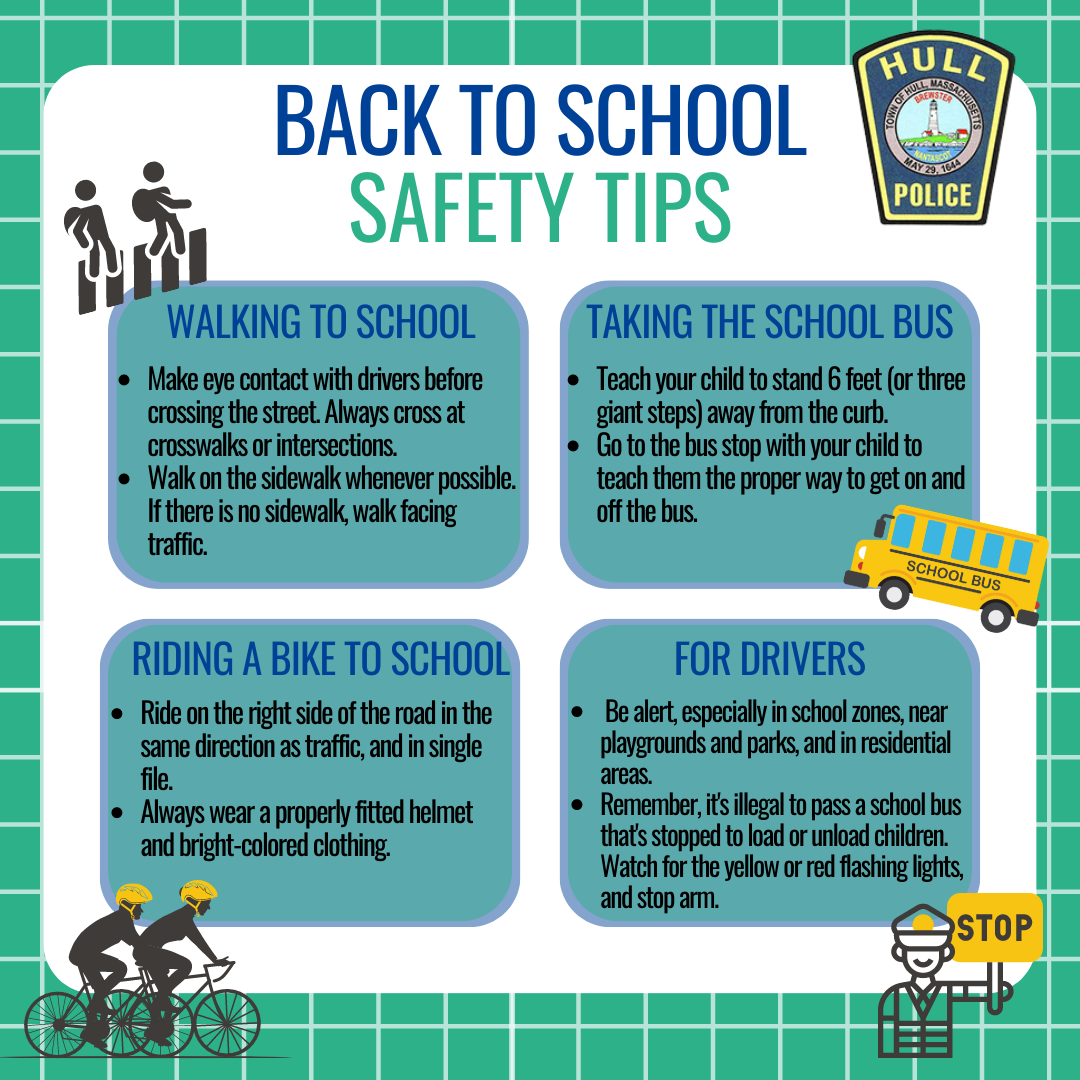HULL — Chief John Dunn and the Hull Police Department would like to offer students, families and motorists important back-to-school travel safety tips as the new school year begins.
Traveling To and From School
Walking to school:
- Walk on the sidewalk whenever possible. When on a street with no sidewalk, walk facing traffic.
- Before crossing the street, stop and look left, right and left again to see if cars are coming.
- Make eye contact with drivers before crossing the street and always cross streets at crosswalks or intersections.
- Stay alert and avoid distracted walking. Never walk while texting. If you need to respond to a text, move out of the way of others and stop on the sidewalk. Never cross the street while using an electronic device. Do not wear earbuds while walking across the street.
Riding a bike to school:
- Ride on the right side of the road in the same direction as traffic, and in single file.
- Come to a complete stop before crossing the street, and walk bikes across the street.
- Stay alert and avoid distracted riding.
- Always wear a properly fitted helmet and bright-colored clothing.
Riding the bus to school:
- For parents:
- Go to the bus stop with your child to teach them how to properly get on and off the bus.
- Teach your children to stand 6 feet (or three giant steps) away from the curb.
- If your child must cross the street in front of the bus, teach him or her to walk on the side of the road until they are 10 feet ahead of the bus. Your child and the bus driver should always be able to see each other.
- For students:
- Wait until the bus has stopped and the door opens before approaching the bus or standing up on the bus.
- Remind children to look to the right before they step off the bus.
- Never walk behind the bus.
Visit the National Safety Council (NSC) for more information.
Safety Tips for Motorists
It is important that motorists stay alert while driving, especially in school zones, near playgrounds and parks, and in residential areas. Remember to never drive while distracted by talking or texting on your phone, eating or drinking, talking to passengers, or fiddling with entertainment or navigation systems.
Drivers are reminded that Massachusetts law states that no motor vehicle operator may use electronic devices while driving unless the technology is being used hands-free.
Around buses:
- Never pass a bus from behind – or from either direction if you’re on an undivided road – if it is stopped to load or unload children. If the yellow or red lights are flashing and the stop arm is extended, traffic must stop. It is illegal in all 50 states to pass a school bus that is stopped to load or unload children.
- The area 10 feet around a school bus is the most dangerous for children. Stop far enough back to allow them space to safely enter and exit the bus.
- If you’re driving behind a bus, allow a greater following distance than if you were driving behind a car.
In a school zone or at school:
- In a school zone when flashers are blinking, stop and yield to pedestrians crossing the crosswalk or intersection. Always stop for a school patrol officer or crossing guard holding up a stop sign.
- Drivers who are dropping students off at school should obey school zone speed limits and follow the school’s drop-off procedures.
Around pedestrians and cyclists:
- Don’t block the crosswalk when stopped at a red light or while waiting to make a turn. This forces pedestrians to go around you, which could put them in the path of moving traffic.
- Make eye contact with pedestrians who are crossing the street.
- Never pass a vehicle stopped for pedestrians.
- When passing a bicyclist, proceed in the same direction slowly, and leave 3 feet between your car and the cyclist.
- A common cause of a collision is a driver turning left in front of a bicyclist. Watch for bike riders turning in front of you without looking or signaling – children especially have a tendency to do this.
- Watch for bikes coming from driveways or behind parked cars.
Teen Drivers
- According to the Centers for Disease Control and Prevention, in 2019, over 40% of U.S. high school students did not always wear a seat belt when riding in a car driven by someone else. Ensure your teen understands that every person in a vehicle should be buckled up, no matter where they are sitting or how long the trip.
- Teens often crash because they are inexperienced. Have regular conversations with your teen about safe driving practices and laws to ensure they understand the rules of the road.
- Set a good example by driving the way you want your teen to drive.
- Learn more about keeping teen drivers safe here.
###



